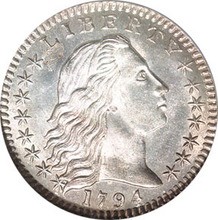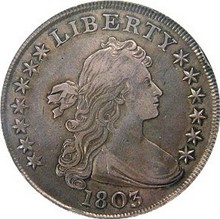 Early American coins (generally those produced from 1793 to about 1839) have been highly demanded among old coin “type” collectors for generations.
Early American coins (generally those produced from 1793 to about 1839) have been highly demanded among old coin “type” collectors for generations.
Among the first U.S. legal tender produced for this country, early US coins bear obverse designs with busts (or head portraits) of Miss Liberty.
The reverses tend to show wreaths and images of eagles. Some of these old coins have lettering stamped on the edges.
Now let’s talk about the value of Early American coins from the 1700s and 1800s, plus some tips for collecting old coins…
Collecting Scarce Old Coins From The 1700s And 1800s
Early American coins seem to be getting scarcer and scarcer as the years go on, and the demand for these old coins is strong in many circles.
The key to buying a really solid early U.S. coin is finding one that:
- is uncleaned
- has no damage
- has a really good strike
That means there are significantly weak areas in the design due solely to the way the coin was produced — but wear is allowed.
Consider all the denominations, dates, and varieties of Early American coins produced from the 1790s through the 1830s. See how they have performed in price over the years.
Value actually isn’t everything in coins – you have to like what you’re collecting. But if you’re hoping to make a profit from the coins you collect, it’s important to look at historical value data in the context of where the market is and where it is going.
There are hundreds of old coins that investors and coin collectors can choose from among these early U.S. coins.
The Value Of Early American Coins In The 1990s vs. Today
 A good number of these early U.S. coins have seen tremendous gains in value over the past decades.
A good number of these early U.S. coins have seen tremendous gains in value over the past decades.
Let’s look at some of these old coins and see how they have changed in value over the years:
- Liberty Cap Half-Cent, 1794-1797: $200 to $20,000 (1990s)
- Liberty Cap Half-Cent, 1794-1797: $500 to $125,000 (Today)
- Classic Head Large Cent, 1808-1814: $30 to $21,000 (1990s)
- Classic Head Large Cent, 1808-1814: $100 to $35,000 (Today)
- Flowing Hair Half-Dime, 1794-1795: $575 to $30,000 (1990s)
- Flowing Hair Half-Dime, 1794-1795: $1,200 to $40,000 (Today)
- Capped Bust Half-Dime, 1829-1837: $13 to $4,000 (1990s)
- Capped Bust Half-Dime, 1829-1837: $50 to $2,200 (Today)
- Draped Bust Dime (Small Eagle Reverse), 1796-1797: $900 to $50,000 (1990s)
- Draped Bust Dime (Small Eagle Reverse), 1796-1797: $2,500 to $100,000 (Today)
- Draped Bust Quarter, 1796: $3,500 to $100,000 (1990s)
- Draped Bust Quarter, 1796: $10,000 to $375,000 (Today)
- Capped Bust Quarter (“Small” Size), 1831-1838: $35 to $18,000 (1990s)
- Capped Bust Quarter (“Small Size”), 1831-1838: $55 to $22,000 (Today)
- Flowing Hair Half-Dollar, 1794-1795: $350 to $125,000 (1990s)
- Flowing Hair Half-Dollar, 1794-1795: $900 to $300,000 (Today)
- Capped Bust Half-Dollar (Lettered-Edge), 1807-1836: $25 to $9,000 (1990s)
- Capped Bust Half-Dollar (Lettered Edge), 1807-1836: $65 to $10,000 (Today)
- Draped Bust Dollar (Heraldic Eagle): $300 to $125,000 (1990s)
- Draped Bust Dollar (Heraldic Eagle): $900 to $180,000 (Today)
*Values listed here are for the “type” price — the lowest price for an example of a certain design. That means these coin prices are based on pieces that are the most common examples of each series in problem-free condition and a grade of Good to Mint-State 65. Cleaned or otherwise damaged specimens are worth less, while scarcer dates or those in better condition are worth more.
Historical Price Trends For Early U.S. Coins
As you can see, for the Early American coins listed above, values have generally increased for the coins that grade “Good.” However, prices have been relatively flat or have even dropped (adjusting for inflation) with some of the mint-state old coins listed here.
Still, prices have been strong of the years for most of the type coins listed here.
That underscores the great demand for some of these early U.S. coins. Price increases have not only been among the high-grade, “investment” level coins, but clearly have been strong for coins in the lower grades, too.
However, while the prices here indicate upward movement for the past several years, there are no sure bets in coin investing.
In fact, some of the prices for the old coins quoted here from the 1990s actually had dropped greatly from much higher levels a few years earlier. That’s because there was a strong investor market in the 1980s, causing many coins to break price records that in some cases haven’t recovered since prices crashed around 1989-1990.
Therefore, bear in mind that the information here should not be used as an investment guide. Invest in coins at your own risk, and remember the coin market can be (and has been in the past) very volatile.
What does the future hold for the values of your Early American coins? Only time will tell…
I’m the Coin Editor here at TheFunTimesGuide. My love for coins began when I was 11 years old. I primarily collect and study U.S. coins produced during the 20th century. I’m a member of the American Numismatic Association (ANA) and the Numismatic Literary Guild (NLG) and have won multiple awards from the NLG for my work as a coin journalist. I’m also the editor at the Florida United Numismatists Club (FUN Topics magazine), and author of Images of America: The United States Mint in Philadelphia (a book that explores the colorful history of the Philadelphia Mint). I’ve contributed hundreds of articles for various coin publications including COINage, The Numismatist, Numismatic News, Coin Dealer Newsletter, Coin Values, and CoinWeek. I’ve authored nearly 1,000 articles here at The Fun Times Guide to Coins (many of them with over 50K shares), and I welcome your coin questions in the comments below!

